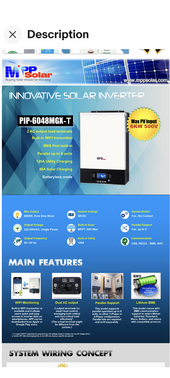So for re-setting the BMS ( on many LiFe batteries ), the circuit needs to be able to individually isolate them on one side - for example the positive connection.
So a common method is to have parallel setups of
- ( battery positive ) --- ( breaker ) --- ( + bus bar ) for each battery in parallel
So for 3 batteries, you would need 3 breakers and attach it to a bus bar.
All of your larger loads would also attach to this bus bar so it will need to be healthy size.
An example breaker would be something like this but you could also use a switch if the only purpose is on / off. I like the dual capability of circuit protection and on / off.
Thermal circuit breakers provide heavy duty circuit protection for 25 to 200 Amp loads when switching and circuit protection are both required.

www.bluesea.com
This is actually a good idea for both Li and AGM batteries IMHO because it makes maintenance so much safer and easier.
__________________
For smaller loads, such as a 12 volt fuse block can be connected the same way to the bus bar, for example
(+ fuse block ) ---- (breaker ) ---- ( + bus bar)
The reason for considering this is that those batteries can really pump out some amps, and a simple ATO fuse in a fuse block might not be capable of stopping it before damaging the fuse block vs the breaker can. It isn't absolutely mandatory, but a good practice.
___________________
With a circuit like this in place, the procedure to do maintenance of all types is to just go in and turn off the breaker for each battery and each source of charging. This will stop power from coming into the circuit.
If you turn on the inverter or any small load for even 10 seconds, it will discharge the capacitors on the input stage of the inverter and output stage of chargers. A volt meter will allow you to tell if it is really down to zero and safe to work on.
Some electricians will carry a small piece of wire and go around and short things out all over before touching anything as an additional precaution. Obviously they have had some experiences......
Meters can behave in weird ways if the batteries start to get low or if they have been dropped too many times.
________________________
As far as re-setting the BMS on a battery in parallel - it is actually slightly difficult to tell if it has tripped or not.
A modern volt meter has very high impedance, so it takes almost negligible amounts of current to register a voltage on a meter. There is a small leakage current though the FET of most Li battery BMS's to be enough to register essentially 12 volts, even if the BMS has tripped.
One way to tell is if you have a clamp meter, you can measure the current in each wire to tell if all of the batteries are in fact having power go in / out. It is a very useful diagnostic tool and anyone who is dependent on their power system like you are really should own one.
___________
Regardless of if you are sure that a BMS has tripped or not, peace of mind can be had by simply turning off the breaker of a battery for 10 seconds, and turning it back on. This can be done one at a time going down the row of batteries and now you can be almost certain that they are all operating.
___________
My wife is pretty competent, but it is a lot easier to convince her to flip off some breakers and turn them back on while talking on the phone than to walk her through getting out tools to disconnect wires and re-attach them.




